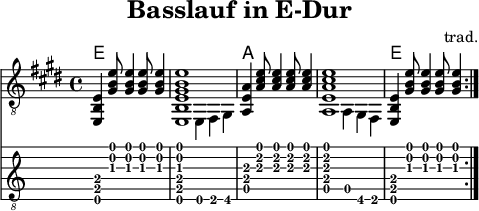Gitarre: Notenlesen - E Fis und Gis
Erscheinungsbild
E Fis und Gis
[Bearbeiten]
Dieser Abschnitt ist noch im Entstehen und noch nicht offizieller Bestandteil des Buchs. Gib den Autoren Zeit, den Inhalt anzupassen!
Malagueña (Motiv im Bass)
[Bearbeiten]- Beachte
- Bei der Tonart A-Moll spielt man den Ton G# zumeist, wenn die Melodie aufwärts geht. Verläuft die Melodie dagegen abwärts, so spielt man zumeist den Ton G.

Bassläufe
[Bearbeiten]Nutze die gerade gelernte Tonfolge für Bassläufe vom E zum A oder Am. In der Tonart Am geht es meist über die Töne F# und und G# aufwärts und über G und F abwärts.

In der Tonart A- oder E-Dur geht es über die Töne G# und F# sowohl auf- als auch abwärts. Die Töne D# und C#, die hier auftauchen, werden wir zu gegebener Zeit genauer ansehen. Hier wird nur der Ton C# gebraucht, den du aber automatisch mit dem A-Dur-Akkord greifst.


